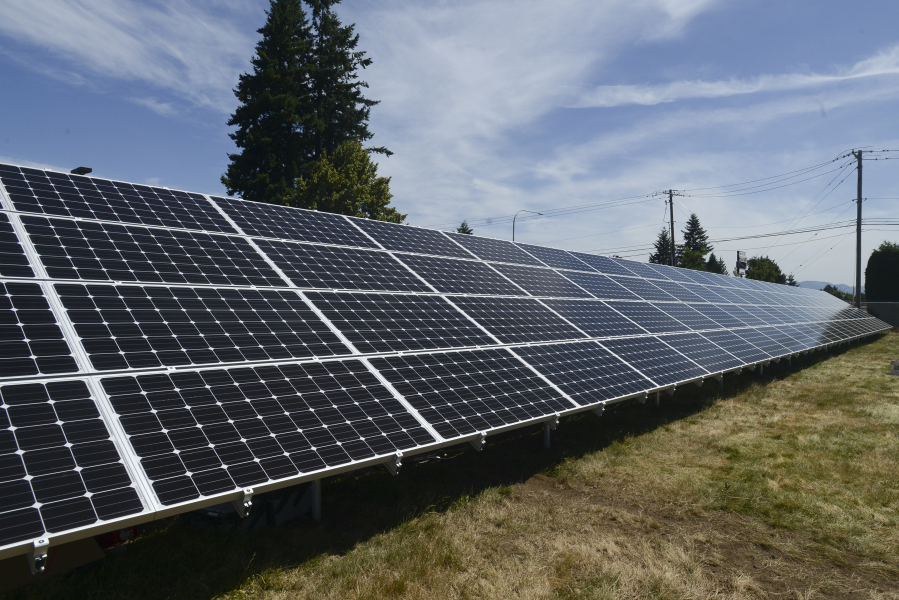Washington isn’t taking advantage of its sunshine, and it’s depressing a segment of the energy market.
“Overall, our solar power increased over the last year, but we’re falling behind and are becoming more of a laggard when the potential for clean energy and local jobs and economic development is so great all over the state,” said Bruce Speight, director of Environment Washington. “We’ve got plenty of sunshine, but we need leadership at all levels with a commitment to clean energy policies.”
Speight’s group on Thursday released its fourth annual solar power report, which ranks states by solar capacity and provides insight into policy decisions that influence the industry.
Though solar power grew in Washington last year — there is now one solar panel for every 28 residents — the report says one reason the state lags behind others is that it lacks a solar “carve-out,” or requirement that a set amount of the state’s power comes from solar.
“We risk falling behind rather than riding that wave,” Speight said.
The Legislature earlier this year also declined to renew or expand solar incentive payments, which expire in 2020.
“The production incentive has contributed greatly to the growth of clean energy in Washington,” reads the Environment Washington report.
The incentive program proved so popular that in some cases too many people signed up for a set pool of state money offered through local utilities throughout the state, including Clark Public Utilities. While that led some utilities to cut their incentive disbursements, Clark Public Utilities is shoring up the payments with money out of its general budget.
Environment Washington, an advocacy group, largely boosts solar energy as capable of combating climate change, though it also says there are jobs on the line, including in Clark County, home to companies like SunModo, which makes racks and mounts for solar panels.
“State leadership on solar policies will translate directly into great local jobs and local economic development in Clark County, where we are expanding our new headquarters, and across the state,” Rick Campfield, CEO of SunModo, said in a press release. “Clean energy is prudent and beneficial for Washington’s environment, energy future and our economy, and we’re eager to work with our local and state leaders to make it happen.”
The top solar-producing states per capita are, unsurprisingly, notoriously sunny: Nevada, Hawaii, California and Arizona top this year’s Environment Washington list. But a few colder states atop the list, such as Vermont and Massachusetts, have high solar capacity per capita as well, due in part to “pro-clean energy policies,” the report says. Environment Washington says nearly all of the solar power produced in the U.S. comes from the top 10 states, which comprise less than a third of the country’s population.
Washington fell to 27th in solar capacity and 30th in solar capacity per capita in 2015, down from 25th in both categories the year prior.
The report said Washington has the capability to produce 21 more times electricity than it uses every year from solar energy.
Clark Public Utilities to cover shortfall in solar program
Clark Public Utilities customers who receive state incentive payments and bill credits for their solar arrays or participation in the community solar program will receive their full expected amounts through the program’s end in 2020, the utility announced Tuesday.
Earlier this year, Clark Public Utilities and several other state utilities realized they had signed up too many people for the incentive program, resulting in a set amount of money from the state needing to be spread too thin.
Rather than cut payments, possibly putting in jeopardy the investments and returns expected by solar users, Clark Public Utilities staff solved the 2 percent “oversubscription” issue by moving operating budget money around so “the utility will provide funding in the amount of the small difference between available state incentives and the reasonable expectations of participants based on the information provided by the utility,” spokeswoman Erica Erland wrote in an email. “There is no rate impact.”
She said the move will cost the utility $40,000 this year and less than $1 million through 2020; Clark Public Utilities’ annual budget is about $360 million.
Commissioners were told of the move, essentially a solar subsidy, in an executive session on potential litigation over the program’s shortfall.
“It became clear to staff that this was not a policy issue, but an operating issue and was resolved with the least-cost, most equitable solution for all customers,” Erland wrote.
The utility is mailing explanatory letters this week to solar incentive program participants.
— Brooks Johnson




